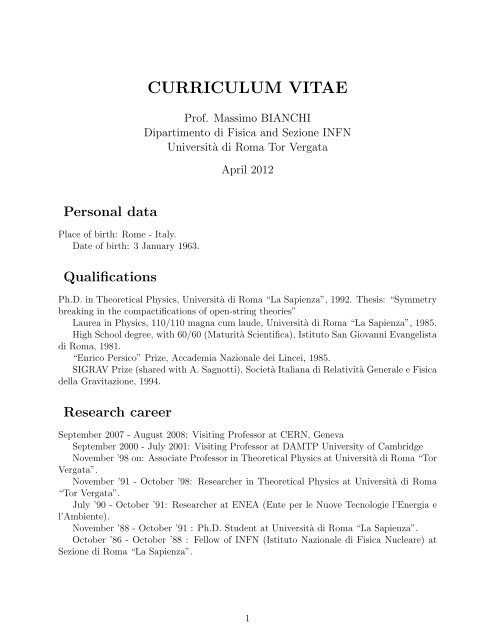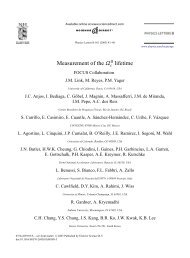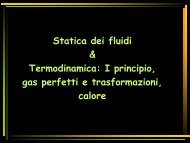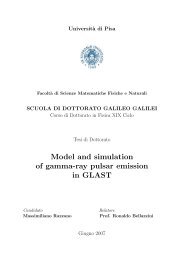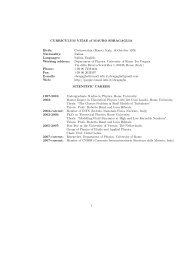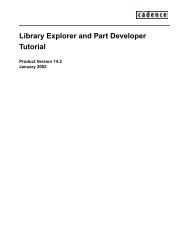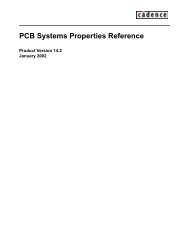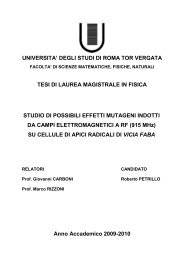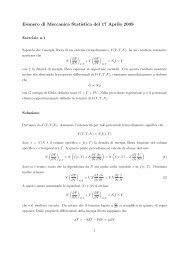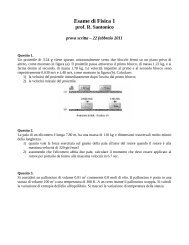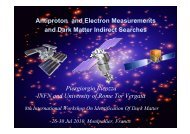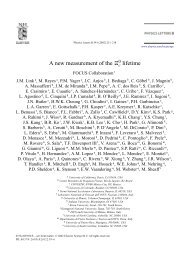You also want an ePaper? Increase the reach of your titles
YUMPU automatically turns print PDFs into web optimized ePapers that Google loves.
<strong>CURRICULUM</strong> <strong>VITAE</strong>Prof. Massimo BIANCHIDipartimento di Fisica and Sezione INFNUniversità di Roma Tor VergataApril 2012Personal dataPlace of birth: Rome - Italy.Date of birth: 3 January 1963.QualificationsPh.D. in Theoretical Physics, Università di Roma “La Sapienza”, 1992. Thesis: “Symmetrybreaking in the compactifications of open-string theories”Laurea in Physics, 110/110 magna cum laude, Università di Roma “La Sapienza”, 1985.High School degree, with 60/60 (Maturità Scientifica), Istituto San Giovanni Evangelistadi Roma, 1981.“Enrico Persico” Prize, Accademia Nazionale dei Lincei, 1985.SIGRAV Prize (shared with A. Sagnotti), Società Italiana di Relatività Generale e Fisicadella Gravitazione, 1994.Research careerSeptember 2007 - August 2008: Visiting Professor at CERN, GenevaSeptember 2000 - July 2001: Visiting Professor at DAMTP University of CambridgeNovember ’98 on: Associate Professor in Theoretical Physics at Università di Roma “TorVergata”.November ’91 - October ’98: Researcher in Theoretical Physics at Università di Roma“Tor Vergata”.July ’90 - October ’91: Researcher at ENEA (Ente per le Nuove Tecnologie l’Energia el’Ambiente).November ’88 - October ’91 : Ph.D. Student at Università di Roma “La Sapienza”.October ’86 - October ’88 : Fellow of INFN (Istituto Nazionale di Fisica Nucleare) atSezione di Roma “La Sapienza”.1
Other AffiliationsResearch associate to INFN at Sezione di Roma “Tor Vergata”,Project Leader of the INFN research network TV12 on “String Theory and FundamentalInteractions”.Member of SIGRAV.Member of the MURST PRIN “Symmetries and Interactions in the Universe” (ProjectLeader Prof. Augusto Sagnotti, SNS)Member of the European Research and Training Network on “Superstrings” (ProjectLeader Prof. Lars Brink, Chalmers)Member of the ERC Advanced Grant “Superfields” (Project Leader Prof. Sergio Ferrara,CERN)Life Member of Clare Hall College at Cambridge University UK.Other chargesCoordinator of the INFN Theory Group at Sezione di Roma “Tor Vergata”. Internal refereeof the INFN research projects in field theory and strings (2002-2007).Coordinator of the research project “Fundamental Interactions and complex systems” atUniversità di Roma “Tor Vergata”.Representative of the Faculty of Sciences in the Committee for the application of the Lawn.104 (equal opportunities for challenged students) at Università di Roma “Tor Vergata”.Member of the coordinating committee of the PhD School in Physics at Universit‘a diRoma “Tor Vergata” (2002-2007).Referee activityNuclear Physics, Physics Letters, Physics Reports, Journal of High Energy Physics, InternalJournal of Modern Physics, Nuovo CimentoBrief summary of research activityMy research interests range from superstring theory to the interplay between gauge theoriesand gravity. The major contribution of my research activity consists in the elaboration withA. Sagnotti, now at Scuola Normale Superiore di Pisa, of a systematic procedure for theconstruction of theories with open and unoriented strings.In a series of papers, from 1987 to 1992, we analyzed the spectra and low-energy interactionsof (non-)supersymmetric open-string theories in various dimensions. We established arelation between patterns of symmetry breaking and anomaly cancellation in the open-stringsector and some world-sheet consistency conditions including the absence of unphysical tadpolesin the closed-string sector. We also noticed the presence of extra antisymmetric tensorsin some six-dimensional models that had no counterpart in similar compactifications of theheterotic string and take part in a generalized Green-Schwarz mechanism of anomaly cancellation.Together with G. Pradisi, we also studied toroidal compactifications of the type Isuperstring and planar duality in the open string descendants of the minimal discrete series.
We identified both continuous deformations, such as Wilson lines that are equivalent to D-brane displacements and important discrete deformations, such as a quantized value of theantisymmetric tensor that leads to the reduction of the rank of the open-string gauge groupand that I later interpreted in terms of non-commuting Wilson lines. We also determinedthe exact form of the emission vertices in an asymmetric superghost picture that allow aminimal coupling of closed-string states in the so-called Ramond-Ramond sector to boundaryand crosscap states. In retrospect, these emission vertices explain why D-branes carryR-R charge.In the period 1992-94, in collaboration with F. Fucito, M. Martellini and G.C. Rossi, Istudied the role of ALE instantons in superstring theory and the non-perturbative effectsinduced by the addition of supersymmetric Yang-Mills fields thereof. We also discussedelectric-magnetic duality in these backgrounds and the possibility of breaking supersymmetrythrough the formation of chiral condensates. Almost at the same time, in collaboration withM. Brunetti, E. Coccia, C. N. Colacino and F. Fucito, I discussed the possibilty of detectingscalar components in gravitational waves through a resonant spherical GW antenna.In 1996, C. Angelantonj and Ya. Stanev joined our group and we investigated the role oftype I vacuum configurations in the web of string dualities. We identified the precise relationbetween the heterotic dilaton and type I dilaton in various dimensions and constructedthe first instance of a chiral three-generation type I model with N=1 supersymmetry infour dimensions. Its phenomelogical perspectives are still under active investigation. Wealso found the unique instance of a six-dimensional model with no tensor multiplets, whoseheterotic dual would have a frozen dilaton. Along this line of investigation, with Ya. StanevI explored the dynamics of open and unoriented strings in the presence of NS penta-branesand non-perturbative effects in unconventional type I vacuum configurations with E. Gava,J. F. Morales and K. Narain.In the period 1998-2001, in collaboration with M.B. Green, S. Kovacs and G.C. Rossi, Istudied non-perturbative effects in the “holographic” correspondence between four-dimensionalN=4 supersymmetric Yang-Mills theory (the “boundary theory”) and type IIB superstringon five-dimensional anti De Sitter space (the “bulk theory”). We showed that instantoncontributions to some correlation functions of gauge-invariant composite operators in theboundary theory and to Wilson loops are precisely reproduced by D-instanton contributionsto the corresponding amplitudes in the bulk theory.Later on, in various collaborations with B. Eden, Ya. Stanev, S. Kovacs and G.C. Rossiwe studied properties of N=4 SYM theory in its superconformal phase and gave an interpretationto the logarithmic behaviour of correlators at short distances in terms of anomalousdimensions of unprotected operators that mix with one another.In the years 2000-01, in collaboration with D. Freedman and K. Skenderis, we havedeveloped what we have termed holographic renormalization, a formalism that allows oneto consistently compute correlation functions, satisfying the correct Ward identities includinganomalies, along RG flows holographically described by (supersymmetric) domain wallsolutions of gauged supergravity in five dimensions. Subsequently, in collaboration with A.Marchetti and then M. Prisco and W. Mück, we have applied this procedure to the computationof three-point correlation functions that allow one to extract decay rates of superglueballstates.I have then started a collaboration with J. F. Morales, H. Samtleben and then N. Beisertaimed at exploiting higher spin symmetry enhancement in the AdS/CFT correspondence.We have been able to precisely match the spectrum of gauge-invariant operators in free N=4
SYM with the type IIB superstring spectrum on AdS 5 timesS 5 extrapolated to the point ofHS symmetry and identify the massive HS representations that participate in a ‘pantagruelic’Higgs mechanism (termed La Grande Bouffe) in the bulk. Later on, in collaboration withF. Riccioni and P. Heslop, we have offered a precise description of the Stückelberg fields thatprovide the longitudinal degrees of freedom to the would-be massless higher spin fields in thebulk and identified the precise form of the operators that are responsible for the emergenceof anomalous dimensions in the boundary CFT.Around 2005, I have resumed my investigations on open unoriented strings with particularemphasys on moduli stabilization and phenomenological applications. In collaboration withE. Trevigne, we analyzed the effect of oblique magnetic fields in configurations with open andunoriented strings. We then computed threshold corrections to gauge couplings and found,together with Anastasopoulos, Sarkissian and Stanev, a general and elegant formula at oneloopin supersymmetric backgrounds. Together with Anastasopoulos, Dudas and Kiritsis,we have identified some generalized C-S couplings in theories with anomalous U(1)’s. I havestudied the effects induced by unoriented D-brane instantons in various context with Kiritsis,Fucito and Morales in several collaborations. In 2008, while at CERN, I have identified a newkind of D-branes present in L-R asymmetric vacua and, together with Elvang and Freedman,derived generating functions for N=8 supergravity amplitudes at tree level and their relationto N=4 SYM amplitudes.Research ProjectsIn the past few years, vacuum configurations of unoriented D-branes have attracted a lotof attention for their promising phenomenological perspectives. In particular, one can considerconfigurations accommodating the Standard Model or some supersymmetric extensionthereof. Comparison with the experimental data requires the knowledge of the low-energyeffective action that describes gauge and Yukawa interactions. We plan to investigate theseissues by studying string amplitudes involving open and closed strings, including those belongingto ‘twisted’ sectors. The relevant D-branes form intersecting stacks that live in anambient space-time with ten dimensions. The resulting D-brane world scenario is compatiblewith the possibility that some of the extra dimensions be large, up to some fraction of amillimeter, and the string tension be rather low, even of a few TeV’s (Tera electron Volts).This would explain the observed weakness of gravity, associated to closed strings, that canpropagate and thus dilute in the whole ambient space-time, while SM particles, associatedto open strings are stuck onto the branes.Spectacular signatures of string excitations could be visible even at the Large HadronCollider LHC at CERN. Other possible signals that may call for new physics beyond theSM, compatible with an underlying superstring description, would be the evidence for thesuper-partners of the known particles or their Kaluza-Klein (KK)recurrences, of massivevector bosons coupled to anomalous abelian currents, and (small) black holes. This fascinatingperspective motivates our intention to work on the interconnected problems of modulistabilization and supersymmetry breaking. Indeed standard string compactifications, thatgeneralize the old idea of Kaluza-Klein, tend to depend on a large number of parameters,known as moduli, that can be identified as the shapes and sizes of the internal spaces andrelated to the classically undetermined vacuum expectation values of massless scalar fields.In order to fix these moduli one has to turn on fluxes and consider non-perturbative effects,generated by instantonic branes, such as non-derivative interactions for the scalar fields.
Although many semi-realistic vacuum configurations have been identified that populate theString Landscape, a fully satisfactory picture is still lacking. In particular there seems to besome tension among various observational constraints such as chirality in the fermion spectrum,the absence of moduli fields, and super-symmetry breaking with a small but positivecosmological constant.Another line of investigation we plan to pursue concerns with a peculiar aspect of quantumgravity: the ”holographic principle”. Holography finds a concrete realization in stringtheory via the ”AdS/CFT correspondence” proposed by J. Maldacena. A particularly interestinginstance of the holographic correspondence between (super-)gravity and (super-)conformal gauge theories relates type IIB superstrings on five-dimensional anti De Sitter(AdS) space, with negative cosmological constant, to N=4 supersymmetric Yang-Mills theory(SYM) on its four-dimensional boundary. The correspondence has been thoroughly testedand generalized, producing many new insights in both quantum gravity and four-dimensionalgauge theories. In models describing Quantum Chromo-Dynamics (QCD), the holographiccorrespondence provides a string interpretation of glue-ball states in terms of closed stringsand meson states in terms of open strings. Holographic renormalization, developed by myselfin collaboration with D. Freedman and K. Skenderis, allows one to consistently computecorrelation functions along RG flows holographically described by domain wall solutions ofgauged super-gravity in five dimensions.In recent times, evidence has been accumulated in favor of the possibility that N=4 SYMtheory be ‘integrable’ in the planar limit, i.e. for a large number of colors. Various techniqueshave been developed that allow to compute in principle the anomalous dimensionof any gauge-invariant operator in N=4 SYM theory at weak coupling and extrapolate theresult to strong coupling. Exploiting higher spin (HS) symmetry enhancement in the limit ofzero coupling, corresponding to high AdS curvature, one can precisely match the spectra inthe two descriptions. The identification of massive HS representations that participate in a‘pantagruelic’ Higgs mechanism, termed ”Grande Bouffe”, in the bulk is a first step towardsclarifying the possible interplay between integrability and HS symmetry. For finite numberof colors, however, N=4 SYM theory and its deformations are known to be non-integrable.Although most of the powerful methods for treating integrable theories do not apply, explicitcomputations of Green functions or scattering amplitudes are greatly simplified if finitenessand conformal invariance of the diagrams are made manifest. We thus propose to investigatedual super-conformal invariance and the interplay between maximally helicity violating(MHV) scattering amplitudes and a certain class of polygonal Wilson loops with light-likeside.References[1] M. Bianchi and G. Inverso, arXiv:1202.6508 [hep-th].[2] M. Bianchi, A. Collinucci and L. Martucci, arXiv:1202.5045 [hep-th].[3] P. Anastasopoulos, M. Bianchi and R. Richter, JHEP 1203 (2012) 068 [arXiv:1110.5424[hep-th]].[4] P. Anastasopoulos, M. Bianchi and R. Richter, arXiv:1110.5359 [hep-th].[5] M. Bianchi and P. Teresi, JHEP 1201 (2012) 161 [arXiv:1108.1071 [hep-th]].
[6] M. Bianchi, A. Collinucci and L. Martucci, JHEP 1112 (2011) 045 [arXiv:1107.3732[hep-th]].[7] M. Bianchi, arXiv:1010.4736 [hep-th].[8] M. Bianchi, L. Lopez and R. Richter, JHEP 1103 (2011) 051 [arXiv:1010.1177 [hep-th]].[9] M. Bianchi, R. Poghossian and M. Samsonyan, JHEP 1010 (2010) 021 [arXiv:1005.5307[hep-th]].[10] M. Bianchi and W. de Paula, JHEP 1004 (2010) 113 [arXiv:1003.2536 [hep-th]].[11] M. Bianchi and L. Lopez, JHEP 1007 (2010) 065 [arXiv:1002.3058 [hep-th]].[12] M. Bianchi, S. Ferrara and R. Kallosh, JHEP 1003, 081 (2010) [arXiv:0912.0057 [hepth]].[13] M. Bianchi, S. Ferrara and R. Kallosh, Phys. Lett. B 690, 328 (2010) [arXiv:0910.3674[hep-th]].[14] M. Bianchi and M. Samsonyan, Int. J. Mod. Phys. A 24, 5737 (2009) [arXiv:0909.2173[hep-th]].[15] M. Bianchi, arXiv:0909.1799 [hep-th].[16] M. Bianchi, F. Fucito and J. F. Morales, JHEP 0908, 040 (2009) [arXiv:0904.2156[hep-th]].[17] M. Bianchi, arXiv:0902.0650 [hep-th].[18] P. Anastasopoulos, M. Bianchi, J. F. Morales and G. Pradisi, arXiv:0901.0113 [hep-th].[19] C. Bachas, M. Bianchi, R. Blumenhagen, D. Lust and T. Weigand, JHEP 0808 (2008)016 [arXiv:0805.3696 [hep-th]].[20] M. Bianchi, Nucl. Phys. B 805 (2008) 168 [arXiv:0805.3276 [hep-th]].[21] M. Bianchi, H. Elvang and D. Z. Freedman, JHEP 0809 (2008) 063 [arXiv:0805.0757[hep-th]].[22] M. Bianchi and S. Ferrara, JHEP 0802 (2008) 054 [arXiv:0712.2976 [hep-th]].[23] M. Bianchi and J. F. Morales, JHEP 0802 (2008) 073 [arXiv:0712.1895 [hep-th]].[24] M. Bianchi, F. Fucito and J. F. Morales, JHEP 0707 (2007) 038 [arXiv:0704.0784 [hepth]].[25] M. Bianchi, S. Kovacs and G. Rossi, Lect. Notes Phys. 737 (2008) 303 [arXiv:hepth/0703142].[26] M. Bianchi and E. Kiritsis, Nucl. Phys. B 782 (2007) 26 [arXiv:hep-th/0702015].[27] P. Anastasopoulos, M. Bianchi, G. Sarkissian and Y. S. Stanev, JHEP 0703 (2007) 059[arXiv:hep-th/0612234].
[28] M. Bianchi, F. A. Dolan, P. J. Heslop and H. Osborn, Nucl. Phys. B 767 (2007) 163[arXiv:hep-th/0609179].[29] M. Bianchi and A. V. Santini, JHEP 0612 (2006) 010 [arXiv:hep-th/0607224].[30] M. Bianchi and J. Kluson, JHEP 0608 (2006) 030 [arXiv:hep-th/0606188].[31] P. Anastasopoulos, M. Bianchi, E. Dudas and E. Kiritsis, JHEP 0611 (2006) 057[arXiv:hep-th/0605225].[32] M. Bianchi and F. Riccioni, J. Phys. Conf. Ser. 33 (2006) 49 [arXiv:hep-th/0601071].[33] M. Bianchi and E. Trevigne, JHEP 0601 (2006) 092 [arXiv:hep-th/0506080].[34] M. Bianchi, P. J. Heslop and F. Riccioni, JHEP 0508 (2005) 088 [arXiv:hepth/0504156].[35] M. Bianchi and V. Didenko, arXiv:hep-th/0502220.[36] M. Bianchi and E. Trevigne, JHEP 0508 (2005) 034 [arXiv:hep-th/0502147].[37] M. Bianchi, Fortsch. Phys. 53 (2005) 665 [arXiv:hep-th/0409304].[38] M. Bianchi, Comptes Rendus Physique 5 (2004) 1091 [arXiv:hep-th/0409292].[39] N. Beisert, M. Bianchi, J. F. Morales and H. Samtleben, JHEP 0407 (2004) 058[arXiv:hep-th/0405057].[40] M. Bianchi, G. D’Appollonio, E. Kiritsis and O. Zapata, JHEP 0404 (2004) 074[arXiv:hep-th/0402004].[41] M. Bianchi, G. Rossi and Y. S. Stanev, Nucl. Phys. B 685 (2004) 65 [arXiv:hepth/0312228].[42] N. Beisert, M. Bianchi, J. F. Morales and H. Samtleben, JHEP 0402 (2004) 001[arXiv:hep-th/0310292].[43] M. Bianchi, M. Prisco and W. Muck, JHEP 0311 (2003) 052 [arXiv:hep-th/0310129].[44] M. Bianchi, J. F. Morales and H. Samtleben, JHEP 0307 (2003) 062 [arXiv:hepth/0305052].[45] M. Bianchi and A. Marchetti, arXiv:hep-th/0302019.[46] M. Bianchi, B. Eden, G. Rossi and Y. S. Stanev, Nucl. Phys. B 646 (2002) 69 [arXiv:hepth/0205321].[47] M. Bianchi, M. B. Green and S. Kovacs, JHEP 0204 (2002) 040 [arXiv:hep-th/0202003].[48] M. Bianchi, D. Z. Freedman and K. Skenderis, Nucl. Phys. B 631 (2002) 159 [arXiv:hepth/0112119].[49] M. Bianchi, M. B. Green and S. Kovacs, arXiv:hep-th/0107028.
[50] M. Bianchi, D. Z. Freedman and K. Skenderis, JHEP 0108 (2001) 041 [arXiv:hepth/0105276].[51] M. Bianchi, S. Kovacs, G. Rossi and Y. S. Stanev, JHEP 0105 (2001) 042 [arXiv:hepth/0104016].[52] M. Bianchi, Nucl. Phys. Proc. Suppl. 102 (2001) 56 [arXiv:hep-th/0103112].[53] M. Bianchi, 8th Marcel Grossmann Meeting on Recent Developments in Theoretical andExperimental General Relativity, Gravitation and Relativistic Field Theories (MG 8),Jerusalem, Israel, 22-27 Jun 1997[54] M. Bianchi and J. F. Morales, arXiv:hep-th/0101104.[55] M. Bianchi, O. DeWolfe, D. Z. Freedman and K. Pilch, JHEP 0101 (2001) 021[arXiv:hep-th/0009156].[56] M. Bianchi and J. F. Morales, JHEP 0008 (2000) 035 [arXiv:hep-th/0006176].[57] M. Bianchi, S. Kovacs, G. Rossi and Y. S. Stanev, Nucl. Phys. B 584 (2000) 216[arXiv:hep-th/0003203].[58] M. Bianchi and J. F. Morales, JHEP 0003 (2000) 030 [arXiv:hep-th/0002149].[59] M. Bianchi, J. F. Morales and G. Pradisi, Nucl. Phys. B 573 (2000) 314 [arXiv:hepth/9910228].[60] M. Bianchi and S. Kovacs, Phys. Lett. B 468 (1999) 102 [arXiv:hep-th/9910016].[61] M. Bianchi, S. Kovacs, G. Rossi and Y. S. Stanev, JHEP 9908 (1999) 020 [arXiv:hepth/9906188].[62] M. Bianchi and S. Kovacs, arXiv:hep-th/9811060.[63] M. Bianchi, E. Gava, F. Morales and K. S. Narain, Nucl. Phys. B 547 (1999) 96[arXiv:hep-th/9811013].[64] M. Bianchi, M. B. Green, S. Kovacs and G. Rossi, JHEP 9808 (1998) 013 [arXiv:hepth/9807033].[65] M. Bianchi, J. Korean Phys. Soc. 33 (1998) S510 [arXiv:hep-th/9712020].[66] M. Bianchi, Nucl. Phys. B 528 (1998) 73 [arXiv:hep-th/9711201].[67] M. Bianchi and Y. S. Stanev, Nucl. Phys. B 523 (1998) 193 [arXiv:hep-th/9711069].[68] M. Bianchi, M. Brunetti, E. Coccia, F. Fucito and J. A. Lobo, Phys. Rev. D 57 (1998)4525 [arXiv:gr-qc/9709045].[69] M. Bianchi, arXiv:hep-th/9702098.[70] M. Bianchi, F. Fucito, G. Rossi and M. Martellini, Phys. Lett. B 359 (1995) 49.
[71] C. Angelantonj, M. Bianchi, G. Pradisi, A. Sagnotti and Y. S. Stanev, Phys. Lett. B387 (1996) 743 [arXiv:hep-th/9607229].[72] M. Bianchi, S. Ferrara, G. Pradisi, A. Sagnotti and Y. S. Stanev, Phys. Lett. B 387(1996) 64 [arXiv:hep-th/9607105].[73] C. Angelantonj, M. Bianchi, G. Pradisi, A. Sagnotti and Y. S. Stanev, Phys. Lett. B385 (1996) 96 [arXiv:hep-th/9606169].[74] M. Bianchi, E. Coccia, C. N. Colacino, V. Fafone and F. Fucito, Class. Quant. Grav.13 (1996) 2865 [arXiv:gr-qc/9604026].[75] M. Bianchi, F. Fucito, G. Rossi and M. Martellini, Nucl. Phys. B 473 (1996) 367[arXiv:hep-th/9601162].[76] M. Bianchi, Nuovo Cim. B 112 (1997) 149 [arXiv:hep-th/9511178].[77] M. Bianchi, F. Fucito and G. Rossi, Phys. Lett. B 359 (1995) 56 [arXiv:hep-th/9507003].[78] G. Beccarini, M. Bianchi, S. Capitani and G. Rossi, Nucl. Phys. B 456 (1995) 271[arXiv:hep-lat/9506021].[79] M. Bianchi and A. Sagnotti, ROM2F-94-39 Lecture at the National Congress on GeneralRelativity and Gravitational Physics, Trieste, Italy, Sep 26-Oct 3, 1994[80] M. Bianchi, F. Fucito, G. C. Rossi and M. Martellini, arXiv:hep-th/9410222.[81] M. Bianchi, F. Fucito, G. C. Rossi and M. Martellini, arXiv:hep-th/9409118.[82] M. Bianchi, F. Fucito, G. C. Rossi and M. Martellini, Nucl. Phys. B 440 (1995) 129[arXiv:hep-th/9409037].[83] M. Bianchi, F. Fucito, E. Marinari and A. Sagnotti, eds. “String theory, quantum gravityand the unification of the fundamental interactions”. Proceedings, Meeting, Rome, Italy,September 21-26, 1992.[84] M. Bianchi, G. Pradisi and A. Sagnotti, Nucl. Phys. B 376 (1992) 365.[85] M. Bianchi, G. Pradisi and A. Sagnotti, Phys. Lett. B 273 (1991) 389.[86] M. Bianchi and A. Sagnotti, Nucl. Phys. B 361 (1991) 519.[87] M. Bianchi and A. Sagnotti, Phys. Lett. B 247 (1990) 517.[88] M. Bianchi and A. Sagnotti, Phys. Lett. B 231 (1989) 389.[89] M. Bianchi and A. Sagnotti, ROM2F-88-040 Presented at Conf. on String Theory,Rome, Italy, Jun 6-10, 1988[90] M. Bianchi and A. Sagnotti, Phys. Lett. B 211 (1988) 407.


